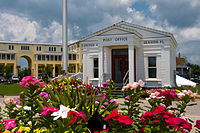
Photo from wikipedia
Abstract Problem, research strategy, and findings: Planners lack clarity about how they can promote the subjective wellbeing (SWB) of the communities they serve. In this research we use descriptive and… Click to show full abstract
Abstract Problem, research strategy, and findings: Planners lack clarity about how they can promote the subjective wellbeing (SWB) of the communities they serve. In this research we use descriptive and econometric methods to explore the interconnections between three aspects of the objective and perceived neighborhood built environment (NBE)—walkability, transit, and parks—and one aspect of SWB—life satisfaction—drawing on a survey of 496 people in the Phoenix (AZ) region. Respondents who were more satisfied with the quantity of neighborhood parks and lived in objectively more walkable neighborhoods expressed higher life satisfaction. Park satisfaction is linked to other life satisfaction–promoting perceptions, including greater neighborhood social connection, nature engagement, exercise opportunities, and lower neighborhood disorder. However, what shapes links between life satisfaction and walkability is less clear. Notably, objective and perceived parks access and walkability were not strongly linked and an understudied factor—perceiving neighborhood geography narrowly—was linked to lower life satisfaction. Planners should be cautious in applying these findings because they do not derive from causal methods or fully account for the propensity of more satisfied people to feel more positively about their environments or live in neighborhoods with particular qualities. Future work should also consider how our findings apply to life satisfaction across diverse places and time. Takeaway for practice: Life satisfaction is associated with neighborhood planning. Planning strategies that may increase residents’ opportunities for higher life satisfaction include a) engaging with communities to better understand and plan for parks that meet residents’ needs and b) enhancing neighborhood walkability. Planners should note that objective measures of the NBE, like walkability and parks, do not necessarily correspond to residents’ perceptions of these qualities. Further investigation into the causal links between the NBE and life satisfaction, including the complex roles that transit accessibility and resident perceptions of neighborhood geography play, is warranted.
Journal Title: Journal of the American Planning Association
Year Published: 2020
Link to full text (if available)
Share on Social Media: Sign Up to like & get
recommendations!